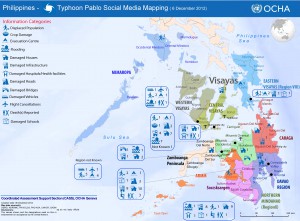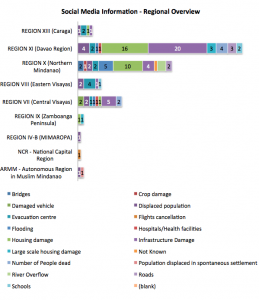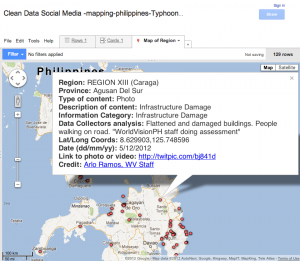
How the UN Used Social Media in Response to Typhoon Pablo
Our mission as digital humanitarians was to deliver a detailed dataset of pictures and videos (posted on Twitter) which depicted the damage and flooding following the Typhoon. An overview of this digital response is available here. The task of our United Nations colleagues at the Office of the Coordination of Humanitarian Affairs (OCHA), was to rapidly consolidate and analyze our data to compile a customized Situation Report for OCHA’s team in the Philippines. The maps, charts and figures below are taken from this official report (click to enlarge).

This map is the first ever official UN crisis map entirely based on data collected from social media.
One of my main priorities now is to make sure we do a far better job at leveraging advanced computing and microtasking platforms so that we are better prepared the next time we’re asked to repeat this kind of deployment. On the advanced computing side, it should be perfectly feasible to develop an automated way to crawl twitter and identify links to images and videos.

My colleagues at QCRI are already looking into this. As for microtasking, I am collaborating with PyBossa and Crowdflower to ensure that we have highly customizable platforms on stand-by so we can immediately upload the results of QCRI’s algorithms. In sum, we have got to move beyond simple crowdsourcing and adopt more agile micro-tasking and social computing platforms as both are far more scalable.
One of my main priorities now is to make sure we do a far better job at leveraging advanced computing and microtasking platforms so that we are better prepared the next time we’re asked to repeat this kind of deployment. On the advanced computing side, it should be perfectly feasible to develop an automated way to crawl twitter and identify links to images and videos.
 My colleagues at QCRI are already looking into this. As for microtasking, I am collaborating with PyBossa and Crowdflower to ensure that we have highly customizable platforms on stand-by so we can immediately upload the results of QCRI’s algorithms. In sum, we have got to move beyond simple crowdsourcing and adopt more agile micro-tasking and social computing platforms as both are far more scalable.
My colleagues at QCRI are already looking into this. As for microtasking, I am collaborating with PyBossa and Crowdflower to ensure that we have highly customizable platforms on stand-by so we can immediately upload the results of QCRI’s algorithms. In sum, we have got to move beyond simple crowdsourcing and adopt more agile micro-tasking and social computing platforms as both are far more scalable.
Visit Original (one additional graphic).
Phi Beta Iota: Dr. Patrick Meier is doing what all modern intelligence agencies should be doing. He is harnessing the distributed intelligence of the public (Open Source Intelligence, OSINT, a sub-set of HUMINT). This is not a new concept, nor are the technologies truly new, just cheaper, better, faster, but this is the first time that HUMANS on the ground, HUMANS in the diaspora, and HUMANS able to integrate HUMAN reporting into HUMAN map depictions have reached both the scale and speed necessary to be operationally and tactically relevant. Social media is HUMINT, not Signals or any other kind of technical intelligence. Until “full-spectrum” HUMINT, [80-90% of which is not secret, not in English, and not accessible to CIA or DIA] is properly implemented, policy-makers and operational commanders will continue to be missing half or more of the intelligence deck that is readily available to them if we get our act together. The final graphic is interactive and allows the tactical commander to pull up hand-held photos that are not just date and time stamped, but precision-geospatially stamped. Put bluntly: the DIA HUMINT plan is terribly incomplete, terribly flawed, and will fail just as CIA HUMINT has failed, because it is out of touch with all of the possibilities….trying heroically to do the wrong things righter instead of the right things to begin with.
See Also:
1994 Team O S. 2258 Proposed Questions for Aspin-Brown Commission to Ask
1996 NATIONAL KNOWLEDGE STRATEGY AND THE REVOLUTIONS IN INTELLIGENCE [Steele at DIA JMITC]
2000 Intelligence Reform in Open Government Dialog [National Academy of Public Administration]
2000 Open Source Solutions [Year in Computers 2000]
2006 IJIC 19/1 Intelligence Affairs: Evolution, Revolution, or Reactionary Collapse?”
2009 Intelligence for the President–AND Everyone Else [CounterPunch]
Open Source Intelligence [P2P Foundation]
Yoda: Mind-Mapping Advances–Listening Does Not



